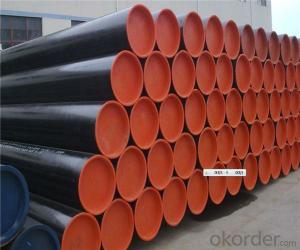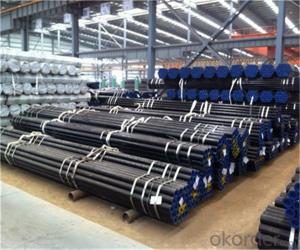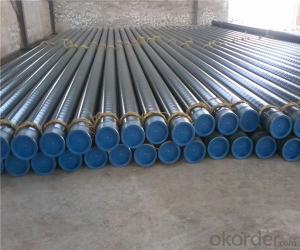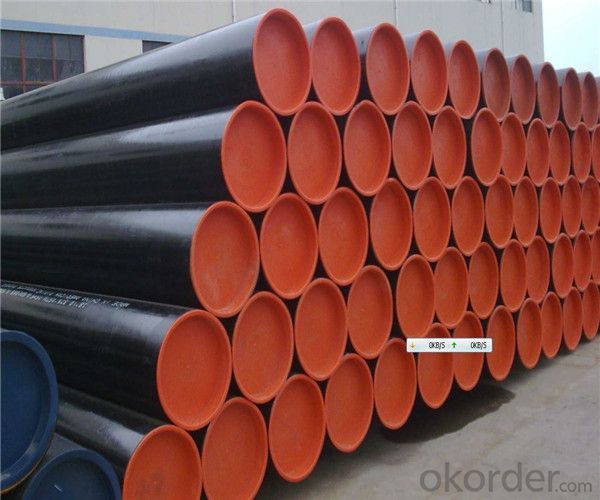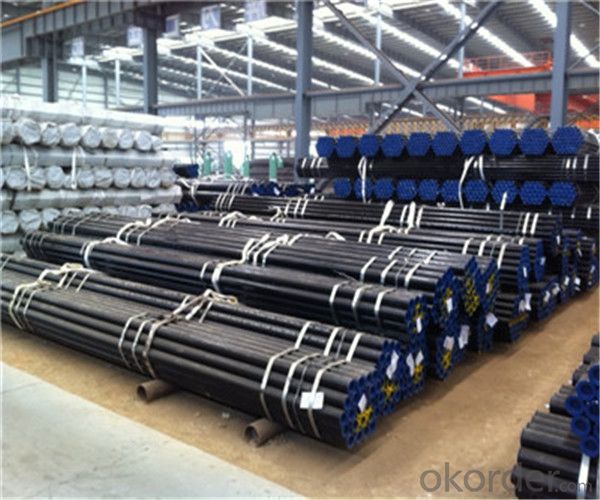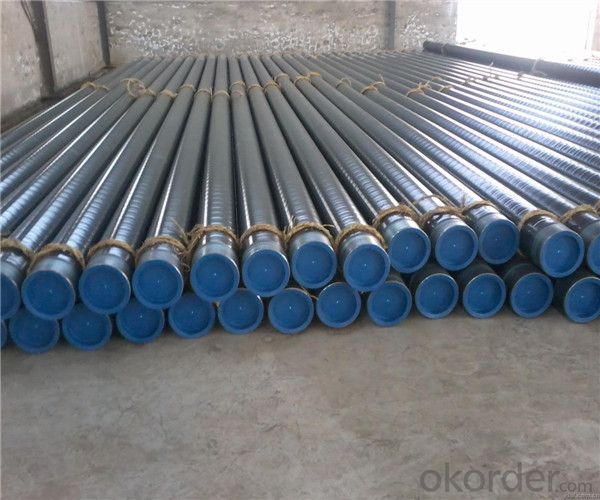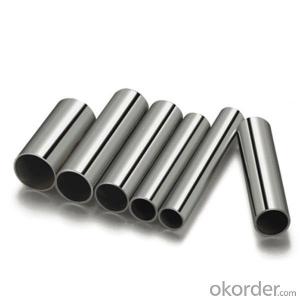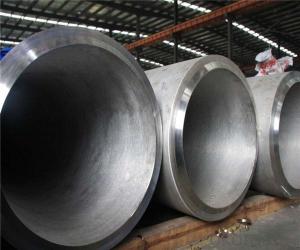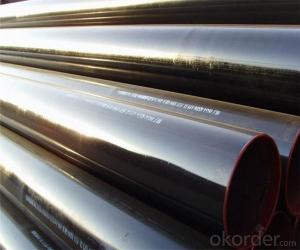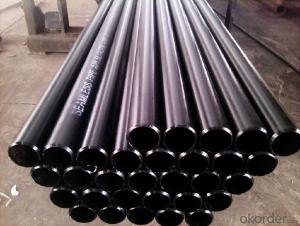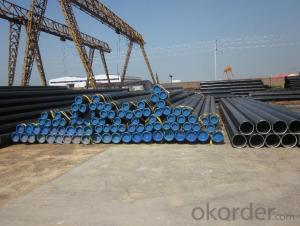Seamless Steel Pipe from CNBM International Corporation
- Loading Port:
- Tianjin
- Payment Terms:
- TT OR LC
- Min Order Qty:
- 25 m.t.
- Supply Capability:
- 1000000 m.t./month
OKorder Service Pledge
OKorder Financial Service
You Might Also Like
1、Structure of Seamless Steel Pipe from CNBM International Corporation:
Seamless pipe is formed by drawing a solid billet over a piercing rod to create the hollow shell. As the manufacturing process does not include any welding, seamless pipes are perceived to be stronger and more reliable. Historically seamless pipe was regarded as withstanding pressure better than other types, and was often more easily available than welded pipe.
2、Main Features of Seamless Steel Pipe from CNBM International Corporation:
• High manufacturing accuracy
• High strength
• Small inertia resistance
• Strong heat dissipation ability
• Good visual effect
• Reasonable price
3、Seamless Steel Pipe from CNBM International Corporation Specification:
Standard | GB, DIN, ASTM ASTM A106-2006, ASTM A53-2007 |
Grade | 10#-45#, 16Mn 10#, 20#, 45#, 16Mn |
Thickness | 8 - 33 mm |
Section Shape | Round |
Outer Diameter | 133 - 219 mm |
Place of Origin | Shandong, China (Mainland) |
Secondary Or Not | Non-secondary |
Application | Hydraulic Pipe |
Technique | Cold Drawn |
Certification | API |
Surface Treatment | factory state or painted black |
Special Pipe | API Pipe |
Alloy Or Not | Non-alloy |
Length | 5-12M |
Outer Diameter | 21.3-610mm |
Grade | 20#, 45#, Q345, API J55, API K55, API L80, API N80, API P110, A53B |
Standard | ASME, ASTM |
1) Material:20#(ASTM A 106/A53 GRB.API5LGRB,GB),45#,16Mn,10#.
2) Specification range:OD:21.3-610mm,WT:6-70mm,length:6-12m or according to the requirement of clients.
3) Excutive standards:GB,ASME API5L.ASTM A 106/A53,Despite of the above standards,we can also supply seamless steel pipe with standard of DIN,JIS,and so on,and also develop new products according to the requirements of our clients!
4) Surface:black lacquered,varnish coating or galvanized.
5) Ends:Beveled or square cut,plastic capped,painted.
6) Packing:bundles wrapped with strong steel strip,seaworthy packing.
4、Packaging & Delivery
Packaging Details: | seaworthy package,bundles wrapped with strong steel strip |
Delivery Detail: | 15-30days after received 30%TT |
5、FAQ of Seamless Steel Pipe from CNBM International Corporation:
①How is the quality of your products?
Our products are manufactured strictly according to national and internaional standard, and we take a test
on every pipe before delivered out. If you want see our quality certifications and all kinds of testing report, please just ask us for it.
Guaranteed: If products’ quality don’t accord to discription as we give or the promise before you place order, we promise 100% refund.
②How about price?
Yes, we are factory and be able to give you lowest price below market one, and we have a policy that “ for saving time and absolutely honest business attitude, we quote as lowest as possible for any customer, and discount can be given according to quantity”,if you like bargain and factory price is not low enough as you think, just don’t waste your time.Please trust the quotation we would give you, it is professional one.
③Why should you chose us?
Chose happens because of quality, then price, We can give you both.Additionally, we can also offer professional products inquiry, products knowledge train(for agents), smooth goods delivery, exellent customer solution proposals.Our service formula: good quality+good price+good service=customer’s trust
SGS test is available, customer inspection before shipping is welcome, third party inspection is no problem.
6、Seamless Steel Pipe from CNBM International Corporation Images:
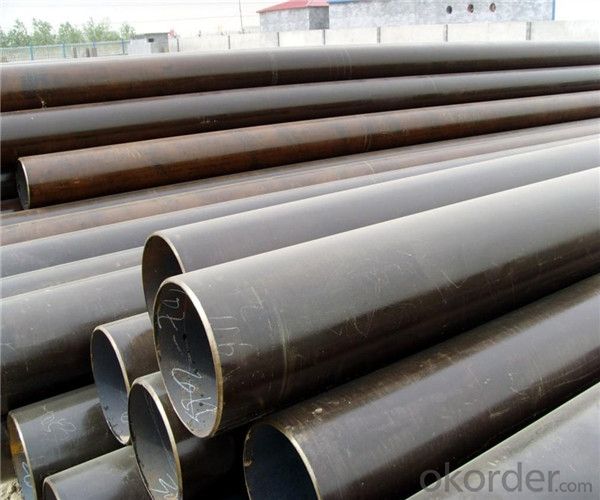

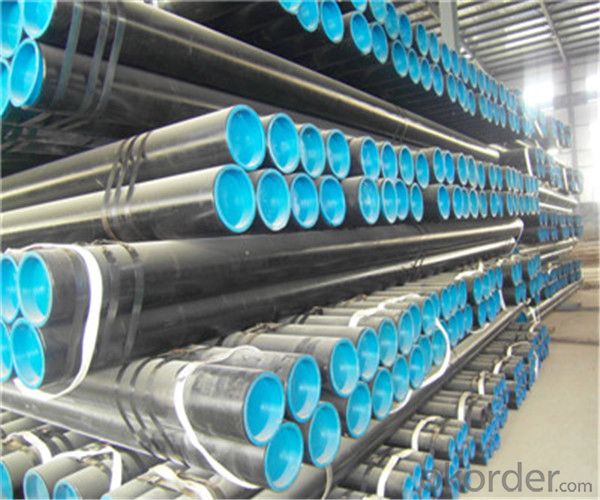
- Q: How are steel pipes used in the construction of wastewater treatment plants?
- Steel pipes are commonly used in the construction of wastewater treatment plants due to their durability, strength, and corrosion resistance. These pipes are used to transport wastewater from different points within the treatment plant, such as pipes for raw sewage, sludge, and treated water. Additionally, steel pipes are also used for structural purposes, such as supporting tanks and other equipment. Overall, steel pipes play a crucial role in the efficient and reliable operation of wastewater treatment plants.
- Q: How are steel pipes threaded for easy installation?
- Steel pipes are threaded for easy installation by using a specialized machine called a pipe threading machine. This machine cuts precise threads onto the ends of the steel pipes, allowing them to be easily connected and tightened together using threaded fittings or couplings. This threading process ensures a secure and leak-proof connection, making installation quick and efficient.
- Q: What is the difference between steel pipes and PPR pipes?
- Steel pipes are made of a durable and strong material, steel, which makes them suitable for carrying high-pressure fluids and gases. On the other hand, PPR (polypropylene random copolymer) pipes are made of a plastic material, which makes them lightweight, corrosion-resistant, and easy to install. PPR pipes are commonly used for plumbing systems, while steel pipes are more commonly used for industrial applications and heavy-duty purposes.
- Q: Can steel pipes be used for underground gas distribution?
- Yes, steel pipes can be used for underground gas distribution. Steel pipes are commonly utilized in the gas industry due to their high strength, durability, and resistance to corrosion. They are capable of withstanding the pressure and stress associated with gas distribution systems. Additionally, steel pipes have been proven to be reliable and safe for transporting natural gas underground. However, it is essential to ensure that the steel pipes are properly coated and protected against corrosion to maintain their integrity and longevity. Regular inspections and maintenance are also necessary to identify and address any potential issues that may arise.
- Q: Can steel pipes be used for conveying slurry and slurries?
- Yes, steel pipes can be used for conveying slurry and slurries. Steel pipes are commonly used for various applications including transporting fluids, gases, and solids. They are known for their durability, strength, and resistance to corrosion, making them suitable for handling abrasive materials like slurry and slurries. Steel pipes are often lined with materials such as rubber or ceramic to provide additional protection against wear and tear caused by the abrasive nature of slurries. The choice of steel grade and lining material depends on the specific requirements of the slurry being conveyed, such as its particle size, concentration, and temperature. Overall, steel pipes are a reliable and efficient option for transporting slurries in various industries including mining, wastewater treatment, and chemical processing.
- Q: Can steel pipes be used for electrical conduit systems?
- Indeed, electrical conduit systems can utilize steel pipes. Steel pipes have gained popularity for electrical conduit systems owing to their robustness and sturdiness. They possess the ability to safeguard electrical wires and cables against physical harm, moisture, and various environmental elements. Additionally, steel pipes exhibit exceptional fire resistance, rendering them suitable for installations in fire safety-conscious buildings. Nevertheless, it is crucial to recognize that steel pipes necessitate adequate grounding to avert electrical shocks and must conform to local building and electrical regulations.
- Q: What are the safety measures to consider when working with steel pipes?
- When working with steel pipes, there are several safety measures to consider. Firstly, it is essential to wear appropriate personal protective equipment (PPE) such as safety glasses, gloves, and steel-toed boots to protect against potential hazards. Additionally, workers should be cautious of sharp edges and take necessary precautions to avoid cuts or lacerations. Furthermore, it is crucial to implement proper lifting techniques and use appropriate lifting equipment when handling heavy steel pipes to prevent back injuries. Adequate training and supervision should be provided to ensure workers are aware of the correct procedures. Another safety measure is to secure the pipes properly to prevent them from rolling or falling, which can cause injuries or damage. Regular inspections of the pipes and the work area should be conducted to identify and rectify any potential hazards. Lastly, workers should be trained on fire safety measures and have access to fire extinguishers or other firefighting equipment in case of emergencies. Proper ventilation should also be ensured when working with steel pipes to avoid inhalation of hazardous gases or fumes. Overall, adhering to safety protocols, using appropriate equipment, and being aware of potential hazards are crucial safety measures when working with steel pipes.
- Q: How do you remove rust from steel pipes?
- One effective way to remove rust from steel pipes is to use a wire brush or steel wool to scrub the affected areas. You can also apply a rust dissolver or a mixture of lemon juice and salt on the rusted spots and let it sit for a few hours before scrubbing. Additionally, using a commercial rust remover or a vinegar solution can also help in removing rust from steel pipes.
- Q: How do steel pipes perform in seismic zones?
- Steel pipes perform well in seismic zones due to their inherent strength and ductility. Their high tensile strength allows them to withstand the horizontal forces exerted during an earthquake, while their ductility allows them to deform and absorb the energy generated by seismic activity. Additionally, steel pipes can be designed and installed with proper reinforcement and bracing systems to further enhance their performance in seismic zones.
- Q: What is the difference between steel pipe and PVC conduit?
- Steel pipe and PVC conduit serve distinct purposes and possess unique characteristics. The material composition stands as a primary distinction between steel pipe and PVC conduit. Steel pipe consists of robust and enduring materials, typically carbon steel or stainless steel, rendering it sturdy and resistant to impact. Consequently, it finds its utility in heavy-duty applications such as plumbing or structural support. In contrast, PVC conduit is constructed from polyvinyl chloride, a type of plastic. PVC's lightweight, flexibility, and ease of manipulation make it ideal for electrical purposes like safeguarding and directing electrical wires. Resistance to corrosion represents another disparity between the two. Steel pipe exhibits greater resistance to corrosion than PVC conduit, particularly when fortified with protective layers like zinc or epoxy. This makes steel pipe suitable for outdoor applications, subterranean installations, or environments with high moisture or corrosive elements. PVC conduit, while generally resistant to moisture and chemicals, may deteriorate over time when exposed to sunlight and can be harmed by specific chemicals. Consideration of cost becomes another factor. Steel pipe generally incurs greater expenses than PVC conduit due to its material and manufacturing process. Nonetheless, steel pipe's durability and extended lifespan establish it as a cost-effective selection in the long run, particularly for applications necessitating high strength and longevity. On the contrary, PVC conduit is comparatively inexpensive and readily accessible, rendering it a more affordable choice for numerous electrical projects. Lastly, installation methods differ between the two. Steel pipe is typically connected through threaded connections or welded joints, mandating specialized tools and skills. Conversely, PVC conduit can be effortlessly cut, assembled, and connected using PVC cement or fittings. This renders PVC conduit a more DIY-friendly option for electrical installations. In summary, steel pipe and PVC conduit diverge in terms of material composition, resistance to corrosion, cost, and installation methods. Steel pipe boasts strength, durability, and corrosion resistance, making it suitable for rigorous applications. PVC conduit, conversely, possesses lightness, flexibility, and affordability, rendering it ideal for electrical projects.
Send your message to us
Seamless Steel Pipe from CNBM International Corporation
- Loading Port:
- Tianjin
- Payment Terms:
- TT OR LC
- Min Order Qty:
- 25 m.t.
- Supply Capability:
- 1000000 m.t./month
OKorder Service Pledge
OKorder Financial Service
Similar products
Hot products
Hot Searches
Related keywords
